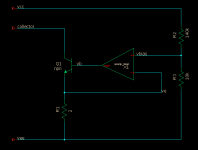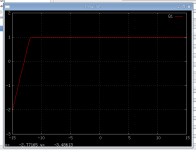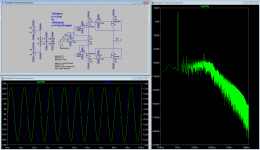When looking through schematics I almost always see some kind of vbe/r setup for current sources. Any reason why opamp based current sources arent used? Are there some stability or transient issue with opamps or something? Something like what I have attached for a 1A current source for biasing a class A output.
Attachments
Why make something simple that works more complicated?
In a commercial design I'd say that cost is an important consideration. A cheap opamp is probably at least 10 times more expensive than a transistor.
In cheap commercial audio devices, you tend to find zener + transistor rather than an integrated voltage regulator. I think for the same reason...
In a commercial design I'd say that cost is an important consideration. A cheap opamp is probably at least 10 times more expensive than a transistor.
In cheap commercial audio devices, you tend to find zener + transistor rather than an integrated voltage regulator. I think for the same reason...
Last edited:
I think one reason is that current sources tend to be floating. If you base it on an opamp, you must make arrangements for the opamp power supply to float as well which adds complexity.
jan didden
Why would the current source be floating? In, for example, an common collector stage it will by the output of the amp stage.
Any reason why opamp based current sources arent used?
Because in 99% of all cases, a simple standard implementation is good enough. There's no point in improving a circuit element which is not a significant performance limitator.
Samuel
Because in 99% of all cases, a simple standard implementation is good enough. There's no point in improving a circuit element which is not a significant performance limitator.
Samuel
Well if you use a simple 2 transistor current mirror you're risking very inaccurate current since youre relying on matching and vbe. Plus burning more idle power. If you use vbe/r by biasing with diodes again youre relying on vbe/r, so inaccurate.
If you use a 50 cent opamp, instead, you get extremely accurate current that does not depend on a random value such as vbe plus much higher rout. How is that not a good trade off given how cheap general purposes opamps are?
Most opamps are +/-15V. This doesn't lend itself well to power amps where the rails are often much higher. Also, it really isn't that critical and even a Wilson mirror is often overkill.
So if you are using a amp with lower rails like +/- 15 there isn't really a downside to using this current source besides "cost"?
So if you are using a amp with lower rails like +/- 15 there isn't really a downside to using this current source besides "cost"?
This is an idea I had earlier
Attachments
cost, and..well, you know their evil right?
Cost is a non issue as general purpose opamps are cheap. What is the other evil?
Fusion,Cost is a non issue as general purpose opamps are cheap. What is the other evil?
You pose an interesting question and since this is DIY there is no relevance to commercial cost consequences. So guys your arguments against are unfounded.
Fusion,
You pose an interesting question and since this is DIY there is no relevance to commercial cost consequences. So guys your arguments against are unfounded.
my post was tongue in cheek, in the greater scheme of things the cost of even a $4 opamp for a CCS is pretty inconsequential vs some other things. As he mentioned many people will spend a great deal of time and money on matched current sources that would far outstrip the cost of an opamp.
I think the main objection is its not the audiophile way, is perhaps less elegant to some people, has more feedback etc all manner of reasons can be found, I just dont happen to subscribe to any of them. in general audiophiles I have found to be pretty conservative in this area. ive brought up the idea before myself and been shot down
Why would the current source be floating? In, for example, an common collector stage it will by the output of the amp stage.
Not always of course.
Maybe you should then precise your question as to where you exactly want to use the CS.
If you use an opamp-based CS as say a collector load in an LTP you need an opamp supply referenced to V+. You get the point.
No showstopper but why would you want the extra complexcity?
jan
- Status
- This old topic is closed. If you want to reopen this topic, contact a moderator using the "Report Post" button.
- Home
- Amplifiers
- Solid State
- Any reason why opamp based current sources arent uses?


